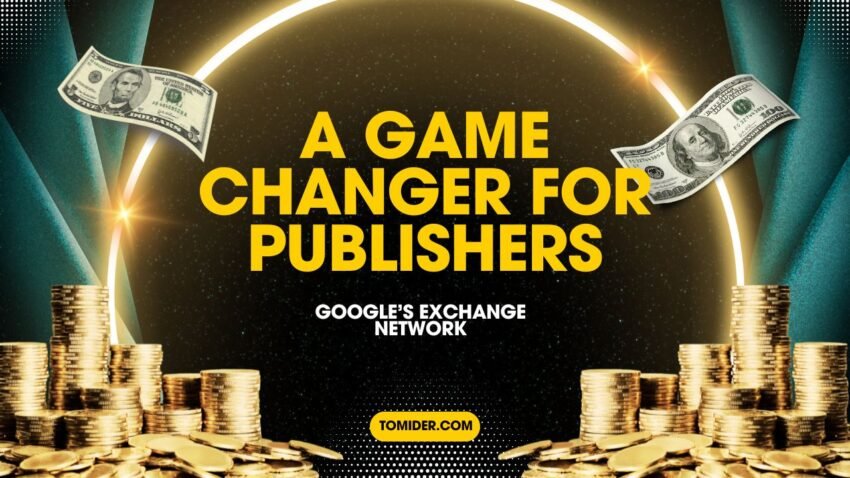
Google’s Exchange Network: A Game Changer for Publishers
Ever wondered how the digital age is continuously reshaping the publishing industry? Google’s Exchange Network could be the next big wave in this evolution, promising a future where publishers have greater control and better revenue opportunities. What exactly is this network, and why should you, as a general reader, care? Let’s dive in and find out!
Introduction to Google’s Exchange Network
Imagine walking into a bookstore where every book knows your name, your interests, and what coffee you like. That’s somewhat what Google’s Exchange Network aims to do for digital publishing. It’s like having a smart assistant that helps publishers deliver the right content to the right audience, only it’s on a massive, digital scale.
Maximizing Revenue with Google AdX: Tips for Publishers
What is Google’s Exchange Network?
Google’s Exchange Network is a platform designed to enhance the interaction between advertisers and publishers. Through this network, publishers gain access to a larger pool of advertisers, ensuring that their ad spaces are filled with high-quality, relevant ads. It’s a win-win: advertisers reach their desired audience, and publishers optimize their ad revenue.
Here are a few possibilities:
- Google Ad Exchange (AdX): Previously known as DoubleClick Ad Exchange, Google AdX is a real-time marketplace partnered with the Google Display Network for buying and selling advertising. It allows digital advertisers and publishers to buy and sell advertising space via real-time bidding.
- Google Cloud Interconnect: Part of Google Cloud, this service allows enterprises to connect their on-premises networks to Google Cloud through various types of physical and virtual connectivity. This helps in achieving lower-latency, highly available, and more secure connections.
- Google Ads Display Network: This network allows businesses to place ads on a variety of news sites, blogs, and other niche sites across the internet to reach more potential customers.
Benefits for Publishers
Why is this network a game changer? For starters, it increases the efficiency of selling ad space. Publishers can manage their ad inventory more effectively, leading to better monetization of their digital real estate. Moreover, it automates many processes, reducing the need for extensive manual intervention.
How It Works: A Simplified View
Think of it as a giant, digital matchmaking service. Google’s Exchange Network connects publishers with advertisers using sophisticated algorithms that consider the content of the website, the profile of its visitors, and the nature of the ads. This ensures that ads are not only relevant but also positioned to generate maximum engagement.
Impact on Online Advertising
The introduction of Google’s Exchange Network is reshaping online advertising by making it more targeted and relevant. This relevance reduces ad fatigue among viewers and increases the chances of ad clicks, benefiting both publishers and advertisers.
Here are some key aspects of its impact:
- Reach and Targeting: Online advertising has revolutionized the way businesses reach their target audience. With sophisticated targeting tools, advertisers can tailor their messages to specific demographics, interests, and behaviors, ensuring their ads reach the most relevant users.
- Cost-Effectiveness: Compared to traditional advertising channels like TV or print, online advertising often offers better cost-effectiveness. Advertisers can set their budgets, track performance in real-time, and adjust campaigns accordingly, maximizing their return on investment (ROI).
- Personalization: Online advertising allows for highly personalized experiences, where ads can be tailored based on individual preferences, browsing history, and past interactions. This level of personalization enhances user engagement and increases the likelihood of conversion.
- Data Privacy and Regulation: Increasing concerns about data privacy and regulations like GDPR and CCPA have significantly impacted online advertising practices. Advertisers must adhere to stricter guidelines regarding user consent, data collection, and transparency, which can influence targeting strategies and campaign effectiveness.
- Ad Blocking: The rise of ad-blocking software poses a challenge for online advertisers, as it prevents their ads from reaching a portion of the audience. This trend has led advertisers to explore alternative formats such as native advertising and influencer partnerships to bypass ad blockers and engage users more effectively.
- Emergence of New Platforms: The rapid proliferation of social media platforms, mobile apps, and streaming services has diversified the online advertising landscape. Advertisers must adapt their strategies to effectively target users across multiple channels and devices to maintain visibility and relevance.
- Ad Fraud and Ad Quality: Ad fraud remains a significant concern in online advertising, with fraudulent activities such as click fraud and bot traffic costing advertisers billions of dollars annually. Maintaining ad quality and ensuring ads are served to real, engaged users is crucial for optimizing campaign performance and minimizing waste.
- Attribution and Measurement: Measuring the impact of online advertising and accurately attributing conversions across multiple touchpoints can be challenging. Advanced attribution models and analytics tools help advertisers gain insights into the customer journey and optimize their campaigns for maximum impact.
Overall, online advertising continues to play a central role in modern marketing strategies, offering unparalleled reach, targeting capabilities, and measurement tools. However, navigating the evolving landscape requires adaptability, creativity, and a keen understanding of both technological advancements and shifting consumer expectations.
Case Studies: Success Stories
Numerous publishers have seen significant improvements in their ad revenue and user engagement since joining Google’s Exchange Network. These success stories highlight the platform’s potential to transform digital advertising strategies.
The Technical Side: What’s Under the Hood?
While it may sound complex, the technology behind Google’s Exchange Network is quite fascinating. It uses real-time bidding (RTB) technology, which allows advertisers to bid on ad spaces in real time, ensuring that publishers get the best possible rates for their ad slots.
Challenges and Considerations
However, it’s not all smooth sailing. There are challenges such as managing the balance between ad revenue and user experience, ensuring privacy compliance, and adapting to the ever-evolving digital landscape.
Boosting Ad Revenue with Google AdX
The Future of Publishing with Google
The future looks bright with Google’s Exchange Network at the forefront of digital publishing. As more publishers and advertisers embrace this technology, we can expect a more dynamic and responsive advertising environment.
Here are a few key areas where Google might shape the future of publishing:
- Search and Discovery: Google Search remains one of the primary ways people discover content online. Publishers need to optimize their content for Google’s search algorithms to ensure visibility. Google might continue to refine its search algorithms to prioritize high-quality, authoritative content, which can impact publishers’ strategies for content creation and SEO.
- Google News and Google Discover: Google News and Google Discover are platforms where users can find personalized news and content recommendations. Publishers can leverage these platforms to reach a wider audience. The future might see Google further refining its algorithms to provide more personalized and relevant content recommendations, potentially using AI and machine learning to better understand users’ interests and preferences.
- Google AMP (Accelerated Mobile Pages): Google AMP is an open-source initiative that aims to improve the performance of web content on mobile devices. Publishers can use AMP to create fast-loading, mobile-friendly web pages that rank higher in Google search results. The future might see continued adoption of AMP by publishers, as Google emphasizes the importance of mobile optimization and page speed.
- Google News Initiative: Google has launched initiatives like the Google News Initiative to support quality journalism and help publishers succeed in the digital age. The future might see Google investing more resources into these initiatives, providing funding, tools, and training to support journalism and help publishers monetize their content effectively.
- Google AdSense and Ad Manager: Google AdSense and Ad Manager are platforms that publishers can use to monetize their content through advertising. The future might see Google introducing new ad formats, targeting options, and revenue-sharing models to help publishers maximize their ad revenue while providing a positive user experience.
- Google Play Books and Google Play Newsstand: Google Play Books and Google Play Newsstand are platforms where users can purchase and read digital books and magazines. The future might see Google expanding its offerings in the digital publishing space, potentially through partnerships with publishers, authors, and content creators.
Overall, the future of publishing with Google is likely to be shaped by continued innovation in search, AI, mobile optimization, and monetization strategies, with a focus on providing high-quality content and a positive user experience.
How to Get Started
For publishers interested in joining Google’s Exchange Network, the process is straightforward. Start by applying through Google’s platform, then integrate your site with their system, and finally, start optimizing your ad placements.
Conclusion
Google’s Exchange Network is indeed a game changer in the digital publishing arena. By providing tools and technologies that streamline the ad placement process, it empowers publishers to maximize their revenue and enhance the user experience. As this network grows, it could very well redefine the norms of digital advertising and publishing.
FAQs
- What is real-time bidding (RTB)? Real-time bidding refers to the buying and selling of online ad impressions through real-time auctions that occur in the time it takes a webpage to load.
- How does Google’s Exchange Network benefit small publishers? It levels the playing field by giving small publishers access to a large pool of advertisers which was previously accessible only to bigger players.
- Are there any fees to join Google’s Exchange Network? Generally, Google charges a percentage of the ad revenue generated through the network, but the exact details can vary.
- Can publishers’ control which ads appear on their sites? Yes, publishers have control over the categories of ads that appear on their sites, ensuring relevance and appropriateness.
- How does Google’s Exchange Network impact user privacy? Google adheres to strict privacy laws, ensuring that user data is handled responsibly within the network. However, publishers must also be diligent in maintaining user trust and compliance with data protection laws.








Leave a Reply